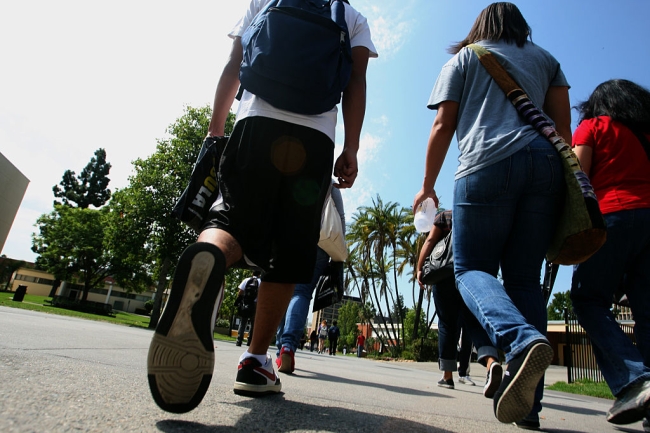You have /5 articles left.
Sign up for a free account or log in.

Transfer students attend an orientation session at California State University, Los Angeles. Transfer enrollment nationwide fell by nearly 8 percent this spring.
Gary Friedman/Contributor/Getty Images
The number of students transferring between colleges continued to decline this spring, dropping nearly 8 percent across all transfer pathways between and among different two-year and four-year institutions.
Community colleges have seen especially steep transfer enrollment declines this semester, while the number of students transferring from two-year colleges to four-year institutions increased slightly, a new National Student Clearinghouse Research Center report shows.
The across-the-board decline in transfer enrollment wasn’t quite as steep as it was this fall, when it fell by more than 8 percent. But the spring decline in transfer rates continued to outpace overall undergraduate enrollment declines.
The number of students moving from one two-year college to another declined by more than 9 percent this spring compared to this time last year, while the number of students transferring from a four-year institution to a two-year institution fell by nearly 21 percent year over year. Combined, these types of transfers make up about 43 percent of all transfers this spring.
The new report on student transfer, mobility and progress, released today, is the third in a series by the National Student Clearinghouse Research Center that looks at student transfer patterns during the pandemic. The latest report looks at transfers as of Feb. 25 and examines year-over-year changes at 74 percent of the institutions that participate in the clearinghouse, which is a nonprofit organization that provides educational reporting, data exchange and research services. The data cover 532,000 transfer students. The report’s results are preliminary and will be updated later this spring.
“Transfer enrollment declines this spring are largely attributable to lower enrollment levels last fall and a higher fall-to-spring attrition rate during COVID-19,” Doug Shapiro, executive director of the National Student Clearinghouse Research Center, said in a statement. “As the pandemic continues to shift the postsecondary landscape, colleges and universities must address the needs of the students who are most impacted.”
The number of transfers from two-year to four-year colleges increased this spring by 3 percent compared to the same time last year, the report shows. It is the only transfer pathway that is not experiencing declines this term. Two-year to four-year transfers also make up the largest piece of the transfer pie, accounting for more than 36 percent of college transfers this spring.
This doesn’t surprise John Fink, a senior research associate at the Community College Research Center and an expert on student transfer. Bachelor’s degrees give most workers a leg up in the labor market, he said.
“The bachelor’s degree is really the credential that is more and more going to secure a more stable position in the labor market. One that, yes, pays more, but also is resilient to economic downturns like the one we’re experiencing,” Fink said. “We know that 80 percent of entering community college students want a bachelor’s degree or higher, which is why transfer is such an important issue in the first place.”
The majority of transfer students move between in-state colleges, and this has remained true during the pandemic. Many community colleges provide a relatively short list of transfer options to students, and many of the institutions that are options are nearby, Fink said.
“Most transfer is happening locally,” Fink said. “Oftentimes, transfer students will look at what's within driving distance to attend a four-year, for the really large number of students want to transfer but not move.”
Prior to the pandemic, spring transfer enrollment was falling among white students, and COVID-19 accelerated that decline, the National Student Clearinghouse Research Center report said. Transfer rates among white students and Black students fell by 13.9 percent and 10.9 percent year over year, respectively. Transfer rates among Asian and Latinx students fell by 6.5 percent and 6.3 percent this spring, respectively.
Demographic trends in transfer vary somewhat by institution type.
“At public four-year institutions, among the four major race and ethnicity groups, only White student transfers experienced a decline from last spring while Latinx transfer enrollment currently shows the strongest growth,” the report said. “On the other hand, public two-year transfer enrollment fell precipitously regardless of race and ethnicity.”
Fewer men are transferring this spring than women, the report shows. Transfer among men fell by 13.5 percent this term compared to the same time last year, and transfer among women fell by 5.9 percent. The transfer rate for women older than 30 increased slightly this spring, by 1.7 percent.
Transfer among continuing students, defined as students who had at least one valid enrollment record in the last fall term, fell by 10.2 percent this spring. Transfer among returning students, which includes students who previously enrolled in postsecondary education but had stopped out until the spring, fell by only 4.9 percent.
Transfer rates are typically lower in the spring than in the fall because fewer students change institutions in the middle of an academic year, according to the report. That said, this spring’s transfer rates still show the effects of the pandemic on enrollment, and those effects are expected to continue.








